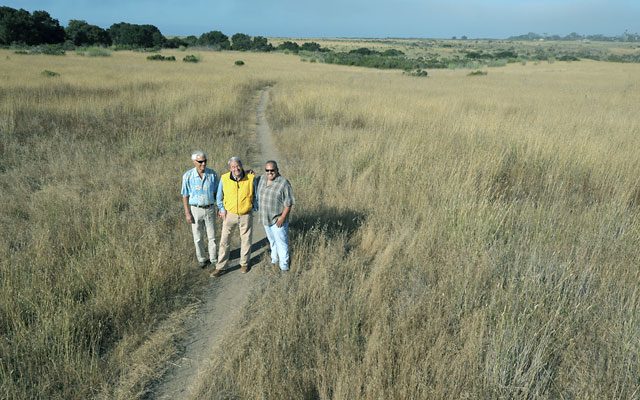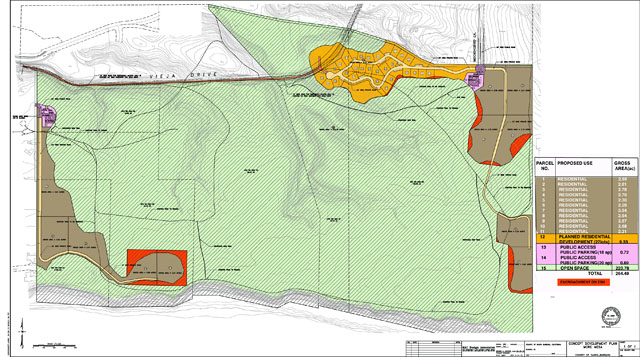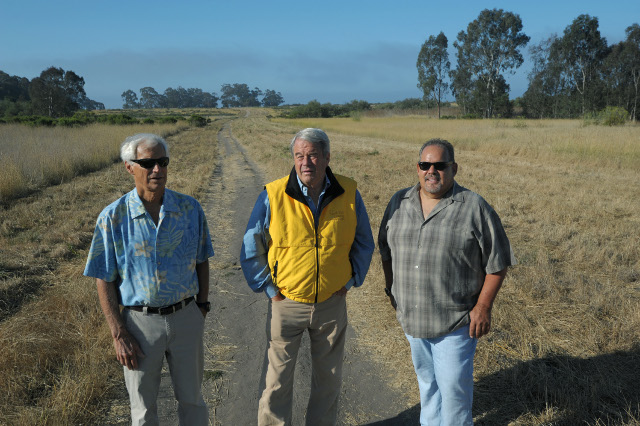
In the orchestra of urban open spaces serenading Santa Barbara, the blufftop expanse of grasslands known as More Mesa just might be the last one left to save. Though today a recreation hub for hikers and bikers, a natural paradise for birdwatchers and flower-lovers, and a well-used portal to the beaches below, the popular property remains privately owned, so the threat of future development floats above the vernal pools and white-tailed kites like a dark cloud.
But for the first time since Robert Earl Holding of Sinclair Oil bought the property for $6.7 million in the mid-1980s — a purchase that’s reportedly caused much consternation for the octogenarian’s family over the years, their private property trampled daily by us everyday citizens — the Holding family is actually endorsing a plan that would preserve 85 percent of the 265 acres they own. To get there, the community would have to get behind the development of 38 homes on 40 acres: 27 eco-minded, wellness-oriented, roughly 3,000-square-foot “casitas” clustered on a nine-acre parcel near today’s Mockingbird Lane, plus 11 mansion-ready parcels fringing the east and west borders of the landscape, with two reaching out closer to the western cliffs. The community would then have to raise money to buy the remaining 225 acres of open space, and while the final cost is yet to be determined, it is expected to be less than $10 million.

Click here for a high-res version of the map above.
“This is an opportunity to legitimize More Mesa at a cost that nobody ever dreamed would be possible,” said Jack Theimer, the developer of Storke Ranch in Goleta, Ennisbrook in Montecito, and Beaver Creek in Colorado who has teamed with environmentally minded attorney Kim Kimbell and real estate agent Stephen Hawkins for the project. “We believe we can build a consensus that allows it to move forward,” explained Theimer, who’s been visiting homeowners associations, reaching out to politicians, and contacting conservation organizations for the past month, but has yet to consult a land use attorney, and has no intention of moving forward if it means a protracted legal battle. “I don’t have the stomach for a fight,” said Theimer, who’s ambitiously hoping for approval in two years and ground-breaking in four.
Leading whatever fight might come would probably be the More Mesa Preservation Coalition, although the 12-year-old, 1,100-member group has not yet taken a formal position. But the group’s leader, Valerie Olson, is sure that what she’s seen does not conform to current planning guidelines, and is already having to calm her worried neighbors. “This is not going to happen in two years,” said Olson, who is actively collecting feedback, holding meetings (with a possible public forum down the road), and investigating whether the community could raise the $45 million currently desired for the whole 265 acres. “It’s a long, community-vetted public process to make anything change on More Mesa.”

A similar sentiment comes from the county’s 2nd District Supervisor Janet Wolf, who first heard of the plan last spring and encouraged the developers to start meeting with neighbors. “With the knowledge that More Mesa is currently zoned for some residential development, it has always been my hope that any development will allow for the greatest possible conservation of land for the public use and enjoyment,” said Wolf, urging that the Goleta Community Plan, Local Coastal Plan, and the 2010 biological study be respected. “I am confident that community members, neighbors, and other stakeholders will remain engaged in what I am sure will be a robust public process.”
At this early stage, both Olson and Wolf are choosing their statements carefully, but some neighbors are more outraged. “They’re not creating a park,” said Craig Cummings, referencing an erroneous headline from last Sunday’s daily paper atop a story that regurgitated the developer’s press release. “They’re destroying a natural habitat.”
The development team, however, believes the opposite, and thinks that, at the very least, they’ve done a lot of hard work to lower the Holding family’s expectations for they might earn from the property. Though once valued at $110 million, Theimer said the Holdings would likely take $35 million for the whole property today, and that if such an offer came at any point in the planning process, he’d “urge them to take it.” But with the state of the economy, Theimer finds that unlikely, and is also quick to point out that if this deal doesn’t go down, the alternatives might be worse: the land could be sold off in the six legal parcels that exist, whose new owners could erect fences and keep out the public, save for trail easements, or the next developer could pursue the 70 houses that current zoning allows for, without preserving the open space.
“If it’s all or nothing, the community loses,” said Theimer. “We took this on because we think it’s a legacy property in the community. It’s a chance to solve the More Mesa equation once and for all.”



